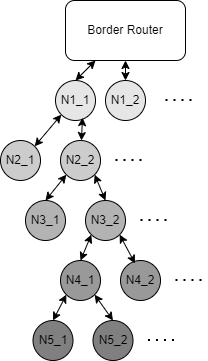SWRA714A July 2021 – November 2023 CC1312PSIP , CC1312R , CC1312R7 , CC1314R10 , CC1352P , CC1352P7 , CC1352R
8 Performance and Test Data
For this revision, a test with a 100-node mesh network and a 5-hop network topology was carried out. The border router pings each device periodically one by one. The ping packet size is 50 bytes; ping interval is 5 seconds with a ping response timeout of 30 s. The test is run for 24 hours.
| Test Parameter | Result |
|---|---|
| End-to-end delay | Hop 1: 373 ms Hop 2: 471 ms Hop 3: 574 ms Hop 4: 760 ms Hop 5: 899 ms Overall average: 583 ms |
| Average packet error rate (PER) | 0.001% |
| Average network join delay | 48.3 minutes |
Looking at the average join delay, the designer must consider that this is tested with a 100-node network with the 5-hop architecture as shown in Figure 4. Every hop incorporates a different number of router nodes. Table 9 lists a differentiation of join delay per hop. The average join delay per hop is defined by the average time it takes from powering up the devices until 100% of the nodes in one hop have joined the network.
An out-of-the-box network with 2-3 nodes joins in 3 to 5 minutes after powering up. The exact join time is dependent on multiple timing factors and the desired data rate. Configure these settings in SysConfig.
 Figure 4 Network Topology for the
100-Node Mesh Network Test
Figure 4 Network Topology for the
100-Node Mesh Network Test| Hop | Number of Routers per Hop | Average Join Delay (Minutes) |
|---|---|---|
| Hop 1 | 32 | 37.3 |
| Hop 2 | 16 | 27.2 |
| Hop 3 | 12 | 58.8 |
| Hop 4 | 20 | 60.5 |
| Hop 5 | 16 | 68 |
| Performance Data | Result |
|---|---|
| Maximum network hops | Wi-SUN® FAN 1.0 standard supports up to 24 hops |
| Maximum network size | Network size is limited by border router's RAM, in addition to application use-case details. TI recommends using up to approximately 100 nodes per border router for devices with 144KB RAM. Multiple border routers can be used to scale the network. TI devices with larger memory can support larger networks. |
| PHY certification results | Wi-SUN® FAN 1.0 PHY
for:
|
| FAN certification results | Wi-SUN® FAN 1.0 certified router stack |
The OAD tests were conducted with an image size of 352256 Bytes using different block sizes. The results vary depending on the number of hops that the data has to travel to the destination. OAD was tested for a maximum hop count of 2. Consider these values to be taken in a mostly noise-free environment. Heavy traffic leads to repeating packets, which increases the total download duration.
| Number of Hops | Block Size (B) | Download Duration (Minutes) |
|---|---|---|
| 1 | 128 | 8:30 |
| 1 | 512 | 3:31 |
| 1 | 1024 | 3:01 |
| 2 | 128 | 15:56 |
| 2 | 1024 | 4:34 |